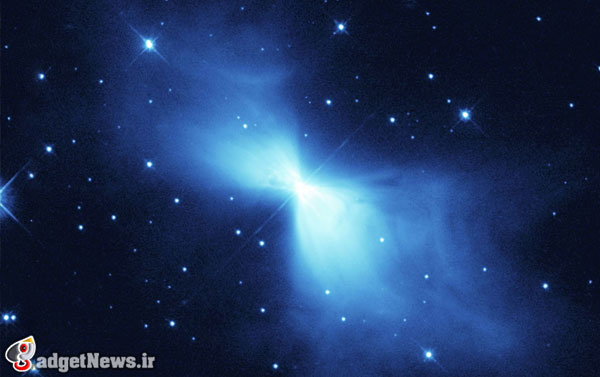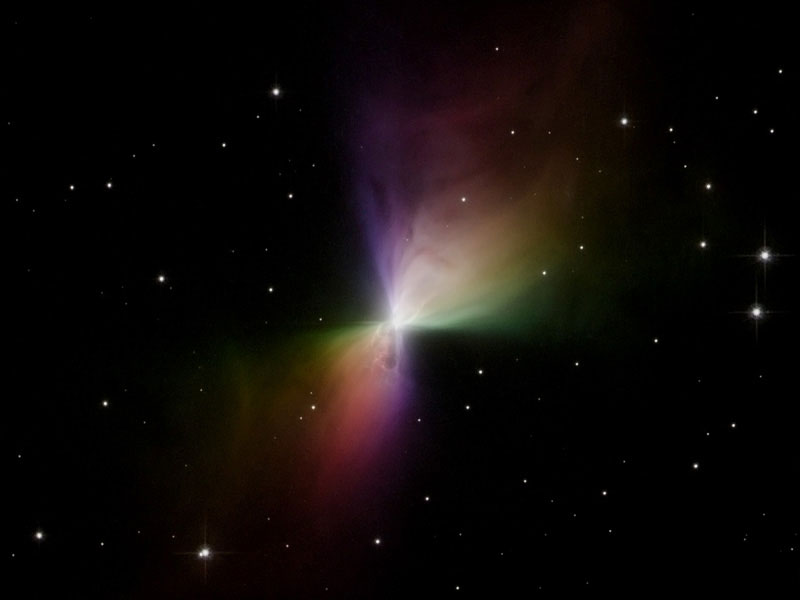
سردترین دمایی که بر اساس قوانین فیزیک میتوان به آن رسید صفر مطلق، یا ۲۷۳/۱۵ – درجهی سلسیوس، است. در آزمایشهای علمی به دماهایی تا یک میلیاردم درجه بالاتر از صفر مطلق رسیدهایم اما برای رسیدن به این دماهای باورناپذیر به تجهیزات پیچیده و گرانقیمت نیاز داریم. عالم چنین تجهیزاتی در اختیار ندارد، پس تا چه حدّ ممکن است سرد شود؟
پاسخ معمول به این پرسش تابش ریزموج زمینهی کیهانی (CMB) است؛ یعنی پستاب باقیمانده از انفجار بزرگ در ابتدای خلقت عالم. دمای این تابش ۲۷۰/۴۲ – درجهی سلسیوس (یعنی فقط ۲/۷۳ درجهی سلسیوس بالاتر از صفر مطلق) است بنابراین فضا را تا چند درجه بالاتر از کمترین دمای ممکن گرم میکند. اما سحابی بومرنگ از این هم سردتر است.

| فریزر کیهانی : برای ساختن این تصویر زیبا با رنگهای کاذب از سحابی بومرنگ چندین عکسِ نور مرئیِ تلسکوپ فضایی هابل، که با فیلترهای پولاریزاسیون گرفته شده، با هم ترکیب شدهاند. ستارهی مرکزی مشغول پرتابکردن لایههای بیرونیتر به فضای خارج است. این لایههای گازی منبسط میشوند و به این ترتیب دمایشان تا یک درجهی سانتیگراد بالاتر از صفر مطلق پایین میرود. درازای هر لُب این سحابی حدود یک سال نوری است. |
بومرنگ از نوع سحابیهای پیشسیارهنماست؛ سحابی سیارهنما از پرتابشدن لایههای گازی از ستارهای در نزدیک پایان زندگیاش ایجاد میشود. ستارهی در حال مرگی که سحابی بومرنگ را تولید کرده باد ستارهای بسیار قدرتمندی داشته است. این باد در ۱۵۰۰ سال آخر زندگی این ستاره با سرعت حدود ۵۹۰ هزار کیلومتر بر ساعت به سوی فضا وزیده است. ستاره با این باد در هر ثانیه حدود ۷۰ هزار میلیارد (۱۵^۱۰×۷۰) تُن ماده را به درون فضا پرتاب میکند. باد ستارهای، علاوه بر سرعت بالا، وقتی به سوی بیرون ستاره جریان مییابد بهسرعت منبسط میشود. این انبساط سریع موجب اُفت چشمگیر دما میشود؛ درست برعکس اثری که موجب میشود هنگام بادکردن لاستیک دوچرخه پمپ باد گرم شود.
نتیجه این است که گازهای سحابی بومرنگ دمای «استخوانسوز» ۲۷۲/۱ – درجهی سلسیوس دارند؛ یعنی سردتر از تابش زمینهی کیهانی. باوجودی که ستارهی مرکزی سحابی بومرنگ خیلی داغ است، ترکیب بادهای پُرسرعت ستارهای و انبساط سریع، سردترین مکان طبیعی شناختهشده در عالم را ایجاد کردهاند که دمایش حتی از فضای بینهایت سرد اطرافش هم کمتر است.
منبع : spacetelescope
The Boomerang Nebula – the coolest place in the Universe?
The Boomerang Nebula is a young planetary nebula and the coldest object found in the Universe so far. The NASA/ESA Hubble Space Telescope image is yet another example of how Hubble's sharp eye reveals surprising details in celestial objects.
This NASA/ESA Hubble Space Telescope image shows a young planetary nebula known (rather curiously) as the Boomerang Nebula. It is in the constellation of Centaurus, 5000 light-years from Earth. Planetary nebulae form around a bright, central star when it expels gas in the last stages of its life.
The Boomerang Nebula is one of the Universe's peculiar places. In 1995, using the 15-metre Swedish ESO Submillimetre Telescope in Chile, astronomers Sahai and Nyman revealed that it is the coldest place in the Universe found so far. With a temperature of -272C, it is only 1 degree warmer than absolute zero (the lowest limit for all temperatures). Even the -270C background glow from the Big Bang is warmer than this nebula. It is the only object found so far that has a temperature lower than the background radiation.
Keith Taylor and Mike Scarrott called it the Boomerang Nebula in 1980 after observing it with a large ground-based telescope in Australia. Unable to see the detail that only Hubble can reveal, the astronomers saw merely a slight asymmetry in the nebula's lobes suggesting a curved shape like a boomerang. The high-resolution Hubble images indicate that 'the Bow tie Nebula' would perhaps have been a better name.
The Hubble telescope took this image in 1998. It shows faint arcs and ghostly filaments embedded within the diffuse gas of the nebula's smooth 'bow tie' lobes. The diffuse bow-tie shape of this nebula makes it quite different from other observed planetary nebulae, which normally have lobes that look more like 'bubbles' blown in the gas. However, the Boomerang Nebula is so young that it may not have had time to develop these structures. Why planetary nebulae have so many different shapes is still a mystery.
The general bow-tie shape of the Boomerang appears to have been created by a very fierce 500 000 kilometre-per-hour wind blowing ultracold gas away from the dying central star. The star has been losing as much as one-thousandth of a solar mass of material per year for 1500 years. This is 10-100 times more than in other similar objects. The rapid expansion of the nebula has enabled it to become the coldest known region in the Universe.
The image was exposed for 1000 seconds through a green-yellow filter. The light in the image comes from starlight from the central star reflected by dust particles.
 گجت نیوز آخرین اخبار تکنولوژی، علم و خودرو
گجت نیوز آخرین اخبار تکنولوژی، علم و خودرو 





